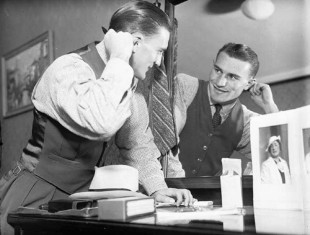CLAY MOYLE
I caught the tail end of a movie on television titled Major League II with my son this past weekend. I’d forgotten how funny it was.
Near the end of the movie there is a scene were a pitcher named Rick “Wild Thing” Vaughn played by Charlie Sheen comes on in relief in a game that will determine whether or not they advance to the World Series. During that scene he purposely walks a man to load the bases so he can face the other teams stud for the final out.
Of course, in typical Hollywood fashion he strikes him out.
That reminded me of a story I’d recently come across in a book about Satchel Paige that my son read for school. Paige was a legendary pitcher in the Negro leagues. He didn’t get a chance to pitch in the Major Leagues until the color line was broken and he was well past his prime, but some say he was the greatest pitcher of all time.
In 1942 his team, the Kansas City Monarchs, faced the Washington-Homestead Grays in the Negro League Championship. Satchel came on in late inning relief to try and help his team win the ballgame. According to legend, he had two outs on the Grays when their leadoff man tripled. At that point, a lengthy discussion took place between Paige and his manager and afterward he intentionally walked the next two batters to load the bases so he could face the Gray’s catcher Josh Gibson.
Josh Gibson was considered the black Babe Ruth of the Negro League and some claim that he hit over 800 home runs during his career. But, despite how dangerous a hitter Gibson was, Paige supposedly walked two men so he could face Josh with the game on the line. He then proceeded to taunt him while striking him out. It sounded like an incredibly reckless move on his part and I was curious to learn more.
So, the first thing I did was look Paige up on-line and the myth was quickly dispelled by Wikepedia. According to that site, the story of Paige intentionally walking the bases full to face Gibson first appeared in a 1948 book titled Pitchin’ Man almost two years after Gibson’s death, and was told in a similar manner in Paige’s 1962 autobiography titled Maybe I’ll Pitch Forever.
But, local and contemporary newspaper accounts of the game indicate Paige retired the inning’s first batter, gave up a single to the second, retired the third batter on a force play, and then surrendered two-out singles to the next two batters to load the bases. That brought Gibson to the plate. Gibson then fouled off two pitches before missing the third strike.
There is no record of Paige taunting Gibson and the games box score indicates Paige didn’t walk a single batter. Too bad, as audacious as it sounded on Paige’s part I thought it was a great story and hoped it was true.
There are numerous stories like that which have been disproved over the years. For example, for the longest time I can remember hearing that the great featherweight boxing champion Willie Pep had once won a round in a fight without throwing a single punch. According to legend, the defensive wizard had purposely gone an entire round without throwing a punch while making his opponent look foolish.
Alas, that legend has been disproved as well.
This type of thing is not uncommon. While I was researching for the biography I wrote about boxer Sam Langford I came across a great story about Sam walking over to his opponent’s corner just prior to the bout, looking him up and down to access his height, and then carefully pacing out a spot on the canvas where he intended to knock him out once the contest began.
I’m still not positive it didn’t happen, because that sounds like the kind of thing Langford might have done. But, I couldn’t find any mention of that at all in any of the local newspaper accounts of the fight I read so I was unable to confirm it actually happened.
One of the better-known legends is Babe Ruth’s called shot in the 1932 World Series. During the third game of the series, Ruth supposedly gestured beyond the center field fence while standing at the plate, and then reportedly hit the next pitch well over the centerfield wall.
You can find a short grainy video of Ruth gesturing with his right hand just prior to hitting the home run on Youtube.com, but many who have seen this maintain that what he was pointing at is inconclusive. So, that particular legend remains a mystery.
Another well-known story that remains a mystery to this day is whether or not Muhammad Ali really threw his 1960 Olympic gold medal in the Ohio River. The story surfaced in the mid-1970s when an Ali biography titled The Greatest: My Own Story came out. Ali wrote the book with Richard Durham and in it he says that there were two incidents that occurred which prompted him to toss his medal into the river.
The first of those was a visit to the mayor’s office in his hometown of Louisville. The mayor was hosting some visiting dignitaries along with Ali and had proudly boasted of Ali’s response to a Russian reporter who had asked him how things were for Negroes in America.
Ali had told the reporter that America was the best country in the world and he’d rather live in Louisville than in Africa where he’d be fighting off snakes and alligators and living in a mud hut.
He came to regret his response and was deeply embarrassed by it.
Then, Ali said that shortly after he and his friend left the mayors’ office on their new motorbikes they came to a restaurant where they came across a small motorcycle gang in leather jackets with Nazi insignias and confederate flags on their backs.
Ali and his brother entered the restaurant but were refused service. Ali claims he pointed out who he was and that he was an Olympic champion, going so far as to show the waitress his medal. But the owner was unimpressed and insisted they wouldn’t be served.
After leaving, the pair ended up getting into an altercation with the motorcycle gang, and once it was over and he and his friend were alone again, Ali said he was so disheartened he ripped the medal from his neck and tossed it into the river.
The story has been repeated many times over the years. But, since that time other Ali biographers such as Thomas Hauser and David Remnick have decided the story was untrue.
Ali’s current wife Lonnie say’s she’s heard him say “Yes” on occasions when asked by someone if the story was true, and simply not reply at other times.
Howard Bingham, Ali’s longtime friend and photographer since 1962 says it didn’t happen, and that Ali simply lost the medal.
A Random House editor who worked on Ali and Durham’s book says that Ali came to deny the story was true when the book came out.
Jeanie Kahnke, a vice president for communications of the Muhammad Ali Center in Louisville says the story is a legend and nobody can say for certain whether it’s true or untrue. She believes that may be the way Ali likes it.
Maybe that’s the way it should remain with some legends.


